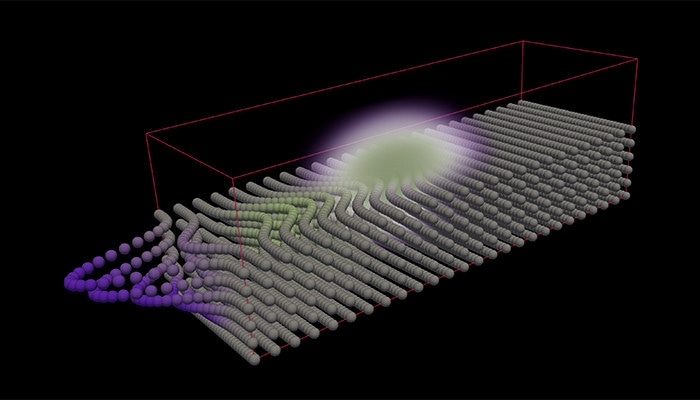Jul 3 2017
Researchers from Aalto University have recently demonstrated that an atomic mass density wave accompanies each and every photon in a transparent medium. The photon’s optical force makes the atoms in the medium to move and forces them to transmit 92% of the total momentum of light, when the medium is silicon. The outcomes of the research have been published recently.
 The optical force on atoms forms a mass density wave that propagates with light through the crystal. CREDIT: Jyrki Hokkanen, CSC.
The optical force on atoms forms a mass density wave that propagates with light through the crystal. CREDIT: Jyrki Hokkanen, CSC.
The innovative finding provides a solution to the centennial momentum paradox of light. In various publications to date, two different values have been reported for the momentum of light in the transparent medium. In general, the values are different by a factor of 10, and this difference is called the momentum paradox of light. This difference is the result of neglecting the momentum of atoms that move along with the light pulse.
In order to provide a solution to the momentum paradox, the Researchers show that the special theory of relativity necessitates an additional atomic density to move along with the photon. Newton’s second law and optical force field are applied in related classical computer simulations to demonstrate that a wave with increased atomic mass density travels along with the light pulse in the medium.
As a result of the mass transfer, the total momentum of light is split into two components. The momentum of the fields equals the Abraham momentum. Whereas the total momentum, including the momentum of atoms thrust onward by the optical force, equals the Minkowski momentum.
Since our work is theoretical and computational it must be still verified experimentally, before it can become a standard model of light in a transparent medium. Measuring the total momentum of a light pulse is not enough but one also has to measure the transferred atomic mass. This should be feasible using present interferometric and microscopic techniques and common photonic materials.
Mikko Partanen, Researcher
Photon mass drag and the momentum of light in a medium - Aalto University Research
See the video: Photon mass drag and the momentum of light in a medium
Potential interstellar applications of the discovery
The research team has been investigating prospective optomechanical applications empowered by the atomic optical shock wave speculated by the new theory. Yet, the theory applies for transparent liquids and solids and also for dilute interstellar gas. We can use an uncomplicated kinematic consideration to demonstrate that in the case of dilute interstellar gas, the energy loss that occurs due to the effect of mass transfer is proportional to the distance traveled by light as well as the photon energy.
This prompts for further simulations with realistic parameters for interstellar gas density, plasma properties and temperature. Presently the Hubble’s law is explained by Doppler shift being larger from distant stars. This effectively supports the hypothesis of expanding universe. In the mass polariton theory of light this hypothesis is not needed since redshift becomes automatically proportional to the distance from the star to the observer.
Professor Jukka Tulkki